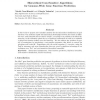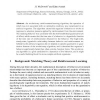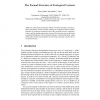954 search results - page 32 / 191 » Principles and Models for Organizing the IT Function |
JMLR
2010
13 years 2 months ago
2010
In this work we propose new ensemble methods for the hierarchical classification of gene functions. Our methods exploit the hierarchical relationships between the classes in diffe...
ECAL
2005
Springer
14 years 1 months ago
2005
Springer
An evolutionary reinforcement-learning algorithm, the operation of which was not associated with an optimality condition, was instantiated in an artificial organism. The algorithm ...
CEC
2007
IEEE
14 years 2 months ago
2007
IEEE
— It is often believed that biological organisms have an inherent tolerance to environmental changes. This is a seductive concept if transferred to artificial organisms. An expe...
IPPS
2002
IEEE
14 years 17 days ago
2002
IEEE
Very large scale networks such as the Internet require a new operational model to use resources efficiently and reduce the need for the administration necessary in clientserver n...
CONTEXT
1999
Springer
13 years 12 months ago
1999
Springer
This paper presents the outline of a formal ontology of contexts. More specifically, it deals with the ontology of ecological contexts (niches, habitats, environments, ambients) an...



